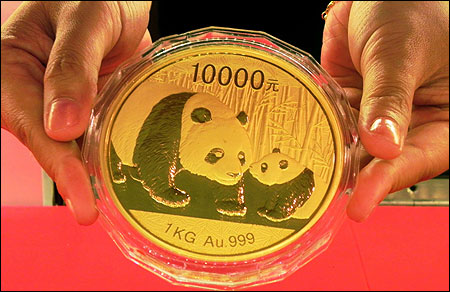
Investors should allocate 10 to 15 per cent in their portfolios to gold through sovereign gold bonds, experts tell Priyadarshini Maji.
The price of gold recently touched a 15-month high of Rs 31,820 per 10 gram. It has, thus, crossed the levels seen in November 2016, the month when demonetisation was announced.
In the global markets, it is trading at around $1,323 an ounce. Over the past year, the yellow metal is up 3.68 per cent in India and 6.90 per cent in the international market.
With both equity and debt markets expected to be volatile in 2018, investors should diversify their portfolios into gold to make them more stable. One reason for the rise in the price of gold in the international market is the dollar's movement.
"When the US Fed started rolling back its quantitative easing (QE) programme, the dollar appreciated. But as others also started tapering, the dollar started weakening against a basket of currencies. This weakening of the dollar over the past year helped gold do well in the international market," says Chirag Mehta, senior fund manager, Quantum Asset Management Company.
Another factor that helped gold's performance is the recent volatility in both global equity and bond markets.
"Global inflation outlook and volatility in other asset classes have also contributed to the upward movement in gold," says Vishal Dhawan, chief financial planner, Plan Ahead Wealth Advisors.
Globally, investors have begun to buy gold as a safe haven that could provide stability to their portfolios in times of volatility.
Rising inflation in the developed world has also propelled investors towards the yellow metal.
The recent crash in the price of bitcoin has also had an impact on gold, at least in the short term.
Earlier, many investors had begun to prefer bitcoin over gold as the alternative asset class in their portfolios.
But the massive fall in its price from $19,351 on December 17, 2017, all the way down to $7,054 on February 6, 2018, led to many investors deciding that they don't have the stomach for such high volatility.
Many such investors have returned to gold.
Mehta, however, says the impact of bitcoin on the price of gold will be marginal and short-term, and the yellow metal's longer-term price movements will be driven more by macroeconomic factors.
In India, the appreciation in the price of gold has been less than in the international market. This is because the rupee has strengthened against the dollar over the past year, leading to lower gains for Indian investors.
Despite being a major consumer of gold along with China -- India accounts for around 20 per cent of annual gold consumption globally -- India is primarily a price taker, which means that prices here are driven by price movements in the international market.
The US Fed has spoken of three more rate hikes this year. Hardening bond yields in the US have already caused panic in asset markets.
"With equities and bonds likely to face a challenging environment, gold could be a good choice for a portion of the portfolio," says Dhawan. He suggests that investors should allocate 10 to 15 per cent in their portfolios to gold through sovereign gold bonds.
Mehta, too, is of the view that investors should have a 10 per cent allocation to gold.
"With such an allocation to gold, returns improve marginally and risk also reduces significantly in the portfolio," he says.
Photograph: ChinaFotoPress/Getty Images










